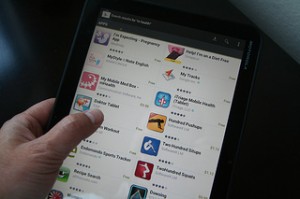 A new study from Tapjoy and Yankee Group reveals that 73% of tablet users and 67% of smartphone users would engage with advertising to access content for free while just 46% of tablet users and 31% of smartphone users would consider purchasing in-app premium content priced between $0.99 and $2.99.
A new study from Tapjoy and Yankee Group reveals that 73% of tablet users and 67% of smartphone users would engage with advertising to access content for free while just 46% of tablet users and 31% of smartphone users would consider purchasing in-app premium content priced between $0.99 and $2.99.
In fact, 80% of mobile device owners reported that they already engage with advertising on a daily basis in exchange for premium content or some form of virtual currency, and nearly 50% do so on a monthly basis or more frequently.
It turns out that mobile consumers are already comfortable engaging with online advertising in order to get free content, and they’re willing to accept more advertising if it means they’ll get more free content or virtual currency. When asked what kind of content mobile consumers would want to receive in exchange for viewing and engaging with advertising, the study found the following breakdown:
- Tablet apps = 77%
- Paperback book = 75%
- MP3 download = 73%
- Table app upgrade/premium content = 73%
- Coffee = 71%
- Smartphone app = 70%
- Smartphone app upgrade premium content = 67%
- Newspaper = 66%
What does this mean for brand marketers? According to Tapjoy’s “Redefining Virtual Currency” report, giving your mobile consumers opportunities to earn virtual currency by willingly engaging with advertising is a key monetization strategy. Consumers have already demonstrated their comfort-level with accepting mobile advertising in exchange for premium content and virtual currency, and they prefer accessing that premium content and other rewards by accepting mobile advertising than paying for it.
Bottom-line, mobile consumers understand that the ads they see are what gives them free content. They expect to see ads, and as long as those ads aren’t obtrusive to the mobile experience, consumers are satisfied. Don’t jump on the premium content or freemium app bandwagon. Instead, consider how advertising and virtual currency could be integrated into your brand’s mobile app to generate revenue and satisfy more customers. In-app mobile advertising can be a positive thing for consumers and brands, so don’t count it out of your app development process.
What do you think? Leave a comment below and share your thoughts on free vs. paid mobile content and in-app advertising.
Image: Intel Free Press
Susan Gunelius is the author of 10 marketing, social media, branding, copywriting, and technology books, and she is President & CEO of KeySplash Creative, Inc., a marketing communications company. She also owns Women on Business, an award-wining blog for business women. She is a featured columnist for Entrepreneur.com and Forbes.com, and her marketing-related articles have appeared on websites such as MSNBC.com, BusinessWeek.com, TodayShow.com, and more.
She has over 20 years of experience in the marketing field having spent the first decade of her career directing marketing programs for some of the largest companies in the world, including divisions of AT&T and HSBC. Today, her clients include large and small companies around the world and household brands like Citigroup, Cox Communications, Intuit, and more. Susan is frequently interviewed about marketing and branding by television, radio, print, and online media organizations, and she speaks about these topics at events around the world. You can connect with her on Twitter, Facebook, LinkedIn, or Google+.


